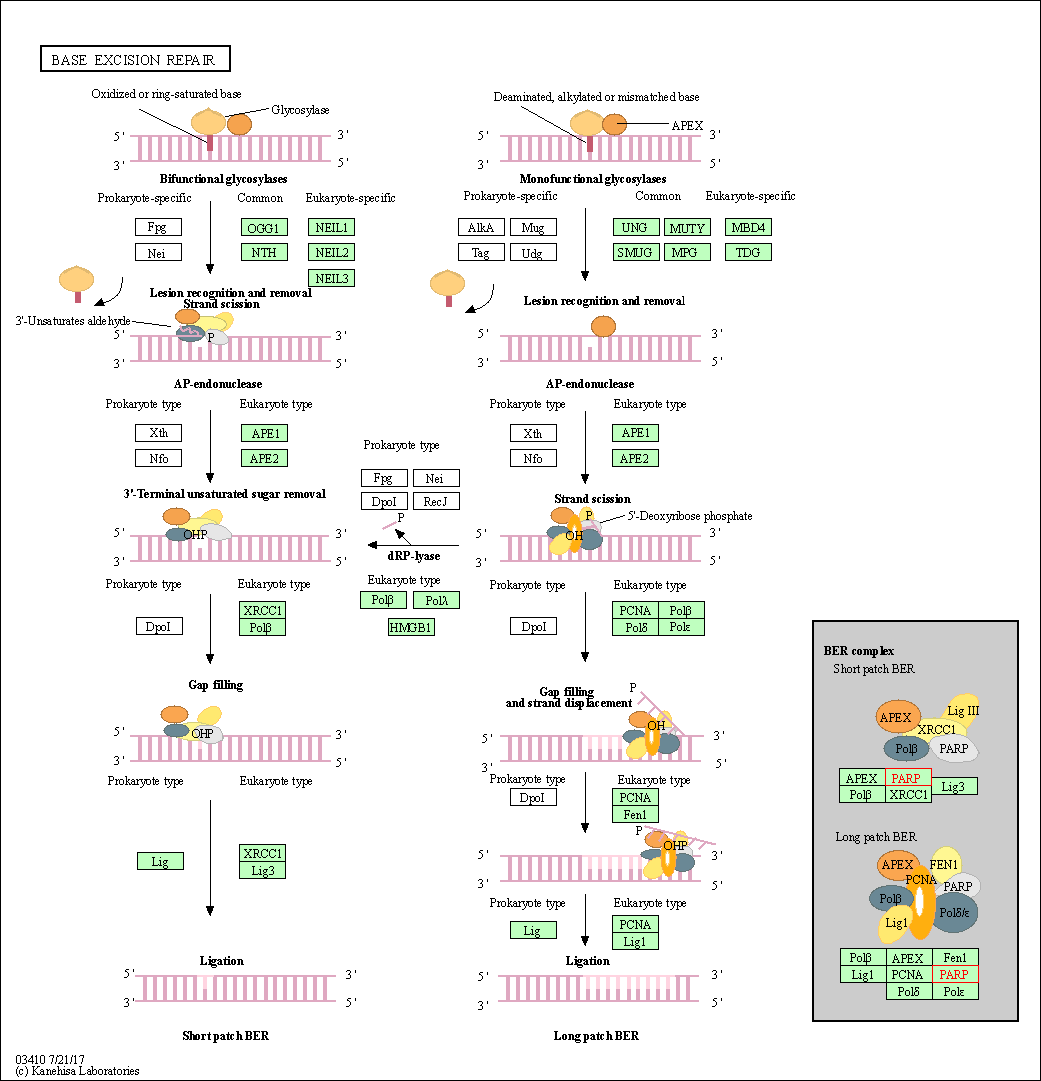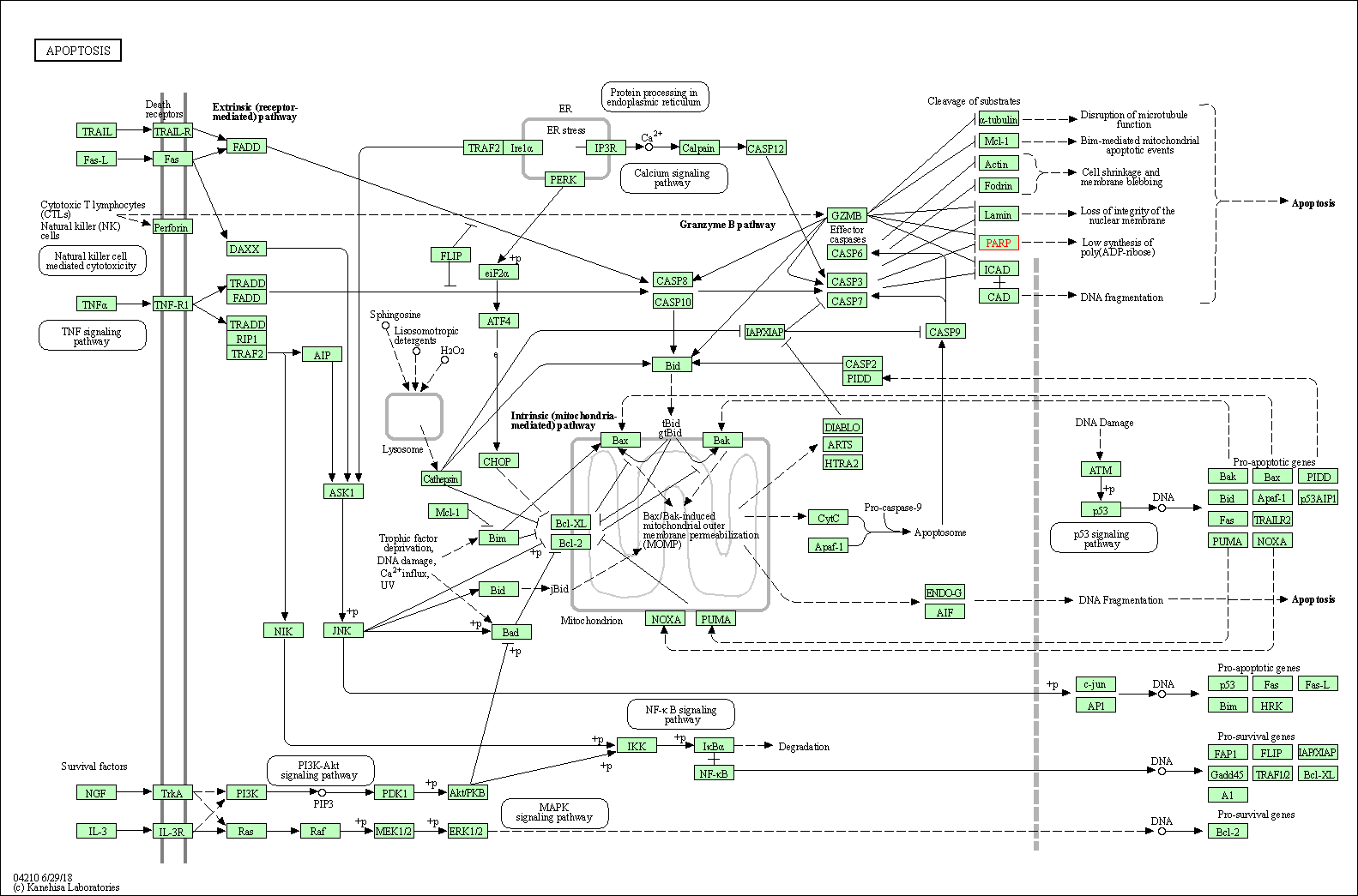Target Information
| Target General Information | Top | |||||
|---|---|---|---|---|---|---|
| Target ID |
T40812
|
|||||
| Target Name |
Poly [ADP-ribose] polymerase 2 (PARP2)
|
|||||
| Synonyms |
pADPRT-2; hPARP-2; Protein poly-ADP-ribosyltransferase PARP2; Poly[ADP-ribose] synthase 2; PARP-2; NAD(+) ADP-ribosyltransferase 2; DNA ADP-ribosyltransferase PARP2; ARTD2; ADPRTL2; ADPRT2; ADPRT-2; ADP-ribosyltransferase diphtheria toxin-like 2
Click to Show/Hide
|
|||||
| Gene Name |
PARP2
|
|||||
| Target Type |
Clinical trial target
|
[1] | ||||
| Disease | [+] 2 Target-related Diseases | + | ||||
| 1 | Ovarian cancer [ICD-11: 2C73] | |||||
| 2 | Solid tumour/cancer [ICD-11: 2A00-2F9Z] | |||||
| Function |
Mainly mediates glutamate and aspartate ADP-ribosylation of target proteins: the ADP-D-ribosyl group of NAD(+) is transferred to the acceptor carboxyl group of glutamate and aspartate residues and further ADP-ribosyl groups are transferred to the 2'-position of the terminal adenosine moiety, building up a polymer with an average chain length of 20-30 units. ADP-ribosylation follows DNA damage and appears as an obligatory step in a detection/signaling pathway leading to the reparation of DNA strand breaks. Also mediates serine ADP-ribosylation of target proteins following interaction with HPF1; HPF1 conferring serine specificity. In addition to proteins, also able to ADP-ribosylate DNA: preferentially acts on 5'-terminal phosphates at DNA strand breaks termini in nicked duplex. Poly-ADP-ribosyltransferase that mediates poly-ADP-ribosylation of proteins and plays a key role in DNA repair.
Click to Show/Hide
|
|||||
| BioChemical Class |
Glycosyltransferases
|
|||||
| UniProt ID | ||||||
| EC Number |
EC 2.4.2.30
|
|||||
| Sequence |
MAARRRRSTGGGRARALNESKRVNNGNTAPEDSSPAKKTRRCQRQESKKMPVAGGKANKD
RTEDKQDGMPGRSWASKRVSESVKALLLKGKAPVDPECTAKVGKAHVYCEGNDVYDVMLN QTNLQFNNNKYYLIQLLEDDAQRNFSVWMRWGRVGKMGQHSLVACSGNLNKAKEIFQKKF LDKTKNNWEDREKFEKVPGKYDMLQMDYATNTQDEEETKKEESLKSPLKPESQLDLRVQE LIKLICNVQAMEEMMMEMKYNTKKAPLGKLTVAQIKAGYQSLKKIEDCIRAGQHGRALME ACNEFYTRIPHDFGLRTPPLIRTQKELSEKIQLLEALGDIEIAIKLVKTELQSPEHPLDQ HYRNLHCALRPLDHESYEFKVISQYLQSTHAPTHSDYTMTLLDLFEVEKDGEKEAFREDL HNRMLLWHGSRMSNWVGILSHGLRIAPPEAPITGYMFGKGIYFADMSSKSANYCFASRLK NTGLLLLSEVALGQCNELLEANPKAEGLLQGKHSTKGLGKMAPSSAHFVTLNGSTVPLGP ASDTGILNPDGYTLNYNEYIVYNPNQVRMRYLLKVQFNFLQLW Click to Show/Hide
|
|||||
| 3D Structure | Click to Show 3D Structure of This Target | PDB | ||||
| HIT2.0 ID | T11WKP | |||||
| Drugs and Modes of Action | Top | |||||
|---|---|---|---|---|---|---|
| Clinical Trial Drug(s) | [+] 3 Clinical Trial Drugs | + | ||||
| 1 | PMID27841036-Compound-37 | Drug Info | Phase 2 | Ovarian cancer | [2] | |
| 2 | Stenoparib | Drug Info | Phase 2 | Ovarian cancer | [3] | |
| 3 | AMXI 5001 | Drug Info | Phase 1/2 | Solid tumour/cancer | [4] | |
| Mode of Action | [+] 1 Modes of Action | + | ||||
| Inhibitor | [+] 6 Inhibitor drugs | + | ||||
| 1 | PMID27841036-Compound-37 | Drug Info | [1] | |||
| 2 | Stenoparib | Drug Info | [3] | |||
| 3 | AMXI 5001 | Drug Info | [5] | |||
| 4 | 3-phenyl isoquinolin-1(2H) derivative 1 | Drug Info | [1] | |||
| 5 | Dihydrodiazepinocarbazolone derivative 1 | Drug Info | [1] | |||
| 6 | Tetra-cyclic pyridophthalazinone derivative 1 | Drug Info | [1] | |||
| Cell-based Target Expression Variations | Top | |||||
|---|---|---|---|---|---|---|
| Cell-based Target Expression Variations | ||||||
| Drug Binding Sites of Target | Top | |||||
|---|---|---|---|---|---|---|
| Ligand Name: Olaparib | Ligand Info | |||||
| Structure Description | HUMAN ARTD2 (PARP2) - CATALYTIC DOMAIN IN COMPLEX WITH OLAPARIB | PDB:4TVJ | ||||
| Method | X-ray diffraction | Resolution | 2.10 Å | Mutation | No | [6] |
| PDB Sequence |
DLGTENLYFQ
232 SMDLRVQELI242 KLICNVQAME252 EMMMEMKYNT262 KKAPLGKLTV272 AQIKAGYQSL 282 KKIEDCIRAG292 QHGRALMEAC302 NEFYTRIPHD312 FGLRTPPLIR322 TQKELSEKIQ 332 LLEALGDIEI342 AIKLVKTELQ352 SPEHPLDQHY362 RNLHCALRPL372 DHESYEFKVI 382 SQYLQSTHAP392 THSDYTMTLL402 DLFEVEKDGE412 KEAFREDLHN422 RMLLWHGSRM 432 SNWVGILSHG442 LRIAHPEAPI452 TGYMFGKGIY462 FADMSSKSAN472 YCFASRLKNT 482 GLLLLSEVAL492 GQCNELLEAN502 PKAEGLLQGK512 HSTKGLGKMA522 PSSAHFVTLN 532 GSTVPLGPAS542 DTGILNPDGY552 TLNYNEYIVY562 NPNQVRMRYL572 LKVQFNF |
|||||
|
|
GLU335
3.338
TRP427
3.958
HIS428
3.306
GLY429
2.798
SER430
4.997
GLY442
4.358
LEU443
3.847
ARG444
3.017
ILE445
4.108
ALA446
3.800
HIS447
4.702
GLY454
5.000
|
|||||
| Ligand Name: Talazoparib | Ligand Info | |||||
| Structure Description | Structure of PARP2 catalytic domain bound to inhibitor BMN 673 | PDB:4PJV | ||||
| Method | X-ray diffraction | Resolution | 2.50 Å | Mutation | No | [7] |
| PDB Sequence |
MDLRVQELIK
243 LICNVQAMEE253 MMMEMKYNTK263 KAPLGKLTVA273 QIKAGYQSLK283 KIEDCIRAGR 296 ALMEACNEFY306 TRIPHDFGLR316 TPPLIRTQKE326 LSEKIQLLEA336 LGDIEIAIKL 346 VKTEEHPLDQ360 HYRNLHCALR370 PLDHESYEFK380 VISQYLQSTH390 APTHSDYTMT 400 LLDLFEVEKD410 GEKEAFREDL420 HNRMLLWHGS430 RMSNWVGILS440 HGLRIAHPEA 450 PITGYMFGKG460 IYFADMSSKS470 ANYCFASRLK480 NTGLLLLSEV490 ALGQCNELLE 500 ANPKAEGLLQ510 GKHSTKGLGK520 MAPSSAHFVT530 LNGSTVPLGP540 ASDTGILNPD 550 GYTLNYNEYI560 VYNPNQVRMR570 YLLKVQFNF
|
|||||
|
|
||||||
| Click to View More Binding Site Information of This Target with Different Ligands | ||||||
| Different Human System Profiles of Target | Top |
|---|---|
|
Human Similarity Proteins
of target is determined by comparing the sequence similarity of all human proteins with the target based on BLAST. The similarity proteins for a target are defined as the proteins with E-value < 0.005 and outside the protein families of the target.
A target that has fewer human similarity proteins outside its family is commonly regarded to possess a greater capacity to avoid undesired interactions and thus increase the possibility of finding successful drugs
(Brief Bioinform, 21: 649-662, 2020).
Human Tissue Distribution
of target is determined from a proteomics study that quantified more than 12,000 genes across 32 normal human tissues. Tissue Specificity (TS) score was used to define the enrichment of target across tissues.
The distribution of targets among different tissues or organs need to be taken into consideration when assessing the target druggability, as it is generally accepted that the wider the target distribution, the greater the concern over potential adverse effects
(Nat Rev Drug Discov, 20: 64-81, 2021).
Human Pathway Affiliation
of target is determined by the life-essential pathways provided on KEGG database. The target-affiliated pathways were defined based on the following two criteria (a) the pathways of the studied target should be life-essential for both healthy individuals and patients, and (b) the studied target should occupy an upstream position in the pathways and therefore had the ability to regulate biological function.
Targets involved in a fewer pathways have greater likelihood to be successfully developed, while those associated with more human pathways increase the chance of undesirable interferences with other human processes
(Pharmacol Rev, 58: 259-279, 2006).
Biological Network Descriptors
of target is determined based on a human protein-protein interactions (PPI) network consisting of 9,309 proteins and 52,713 PPIs, which were with a high confidence score of ≥ 0.95 collected from STRING database.
The network properties of targets based on protein-protein interactions (PPIs) have been widely adopted for the assessment of target’s druggability. Proteins with high node degree tend to have a high impact on network function through multiple interactions, while proteins with high betweenness centrality are regarded to be central for communication in interaction networks and regulate the flow of signaling information
(Front Pharmacol, 9, 1245, 2018;
Curr Opin Struct Biol. 44:134-142, 2017).
Human Similarity Proteins
Human Tissue Distribution
Human Pathway Affiliation
Biological Network Descriptors
|
|
|
There is no similarity protein (E value < 0.005) for this target
|
|
Note:
If a protein has TS (tissue specficity) scores at least in one tissue >= 2.5, this protein is called tissue-enriched (including tissue-enriched-but-not-specific and tissue-specific). In the plots, the vertical lines are at thresholds 2.5 and 4.
|
| KEGG Pathway | Pathway ID | Affiliated Target | Pathway Map |
|---|---|---|---|
| Base excision repair | hsa03410 | Affiliated Target |

|
| Class: Genetic Information Processing => Replication and repair | Pathway Hierarchy | ||
| Apoptosis | hsa04210 | Affiliated Target |

|
| Class: Cellular Processes => Cell growth and death | Pathway Hierarchy | ||
| Degree | 2 | Degree centrality | 2.15E-04 | Betweenness centrality | 4.50E-07 |
|---|---|---|---|---|---|
| Closeness centrality | 1.72E-01 | Radiality | 1.27E+01 | Clustering coefficient | 0.00E+00 |
| Neighborhood connectivity | 1.05E+01 | Topological coefficient | 5.28E-01 | Eccentricity | 13 |
| Download | Click to Download the Full PPI Network of This Target | ||||
| Chemical Structure based Activity Landscape of Target | Top |
|---|---|
| Drug Property Profile of Target | Top | |
|---|---|---|
| (1) Molecular Weight (mw) based Drug Clustering | (2) Octanol/Water Partition Coefficient (xlogp) based Drug Clustering | |
|
|
||
| (3) Hydrogen Bond Donor Count (hbonddonor) based Drug Clustering | (4) Hydrogen Bond Acceptor Count (hbondacc) based Drug Clustering | |
|
|
||
| (5) Rotatable Bond Count (rotbonds) based Drug Clustering | (6) Topological Polar Surface Area (polararea) based Drug Clustering | |
|
|
||
| "RO5" indicates the cutoff set by lipinski's rule of five; "D123AB" colored in GREEN denotes the no violation of any cutoff in lipinski's rule of five; "D123AB" colored in PURPLE refers to the violation of only one cutoff in lipinski's rule of five; "D123AB" colored in BLACK represents the violation of more than one cutoffs in lipinski's rule of five | ||
| Target Poor or Non Binders | Top | |||||
|---|---|---|---|---|---|---|
| Target Poor or Non Binders | ||||||
| Target Affiliated Biological Pathways | Top | |||||
|---|---|---|---|---|---|---|
| KEGG Pathway | [+] 3 KEGG Pathways | + | ||||
| 1 | Base excision repair | |||||
| 2 | Apoptosis | |||||
| 3 | Necroptosis | |||||
| References | Top | |||||
|---|---|---|---|---|---|---|
| REF 1 | PARP inhibitors as antitumor agents: a patent update (2013-2015).Expert Opin Ther Pat. 2017 Mar;27(3):363-382. | |||||
| REF 2 | ClinicalTrials.gov (NCT03878849) Investigation of 2X-121 in Patients With Advanced Ovarian Cancer Selected by the 2X-121 DRP (PREDICT 2X-121). U.S. National Institutes of Health. | |||||
| REF 3 | Clinical pipeline report, company report or official report of Allarity Therapeutics. | |||||
| REF 4 | ClinicalTrials.gov (NCT04503265) A Trial of AMXI-5001 for Treatment in Patients With Advanced Malignancies. U.S. National Institutes of Health. | |||||
| REF 5 | AMXI-5001, a novel dual parp1/2 and microtubule polymerization inhibitor for the treatment of human cancers. Am J Cancer Res. 2020 Aug 1;10(8):2649-2676. | |||||
| REF 6 | Structural Basis for Potency and Promiscuity in Poly(ADP-ribose) Polymerase (PARP) and Tankyrase Inhibitors. J Med Chem. 2017 Feb 23;60(4):1262-1271. | |||||
| REF 7 | Structural basis for the inhibition of poly(ADP-ribose) polymerases 1 and 2 by BMN 673, a potent inhibitor derived from dihydropyridophthalazinone. Acta Crystallogr F Struct Biol Commun. 2014 Sep;70(Pt 9):1143-9. | |||||
If You Find Any Error in Data or Bug in Web Service, Please Kindly Report It to Dr. Zhou and Dr. Zhang.

